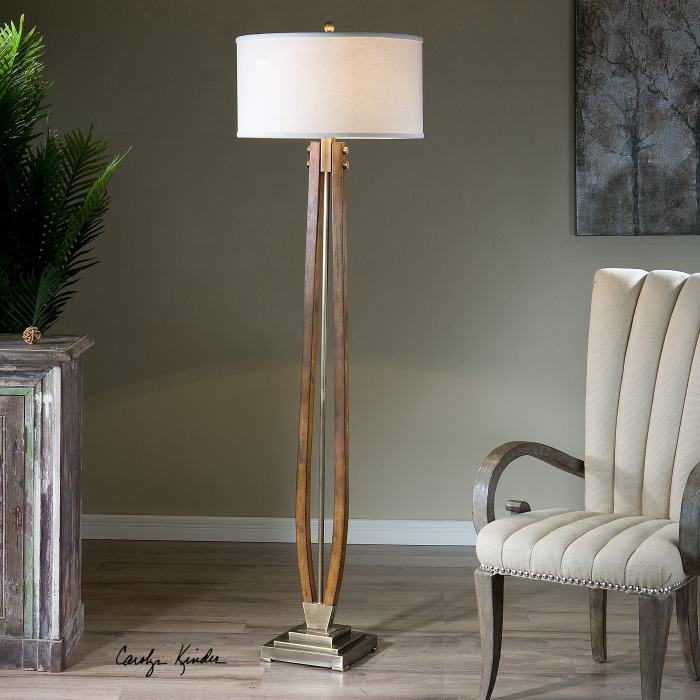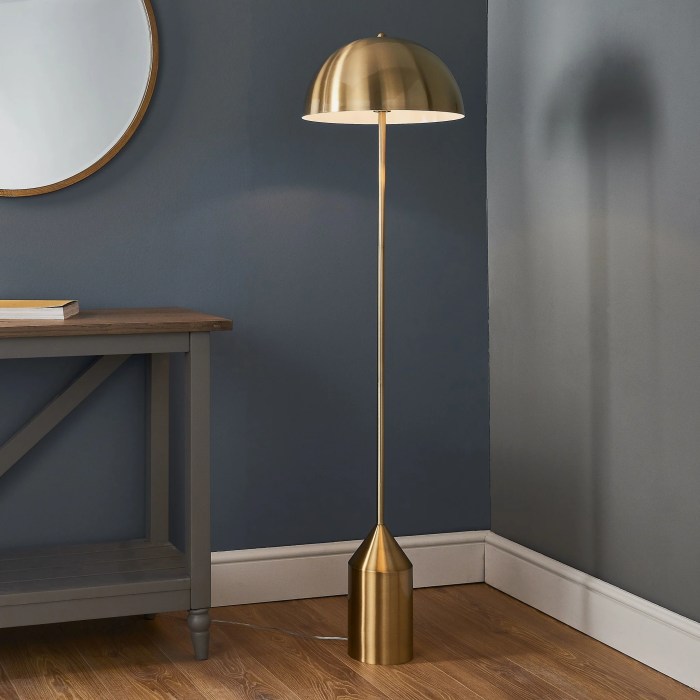Floor lamps stand tall, illuminating our homes with both function and flair. From traditional designs to modern masterpieces, floor lamps offer a versatile and stylish way to brighten up any space.
As we delve into the world of floor lamps, we’ll explore their diverse designs, functional aspects, placement strategies, and decorative applications. Along the way, we’ll uncover the secrets to choosing the perfect floor lamp for your needs and creating a space that’s both inviting and stylish.
Floor Lamp Design and Styles
Floor lamps are a versatile and stylish addition to any home. They can provide both ambient and task lighting, and they come in a wide range of designs to suit any taste.
Traditional floor lamps typically have a metal or wood base with a fabric shade. Modern floor lamps often feature sleek lines and minimalist designs, while contemporary floor lamps may incorporate more unusual materials and shapes. Industrial floor lamps are typically made of metal and have a more utilitarian look.
Materials
Floor lamps can be made from a variety of materials, including metal, wood, glass, and fabric. Metal floor lamps are durable and easy to clean, while wood floor lamps add a touch of warmth and natural beauty to a space.
Glass floor lamps can be elegant and modern, while fabric floor lamps can provide a softer, more diffused light.
Finishes
Floor lamps are available in a variety of finishes, including brushed nickel, polished brass, and painted finishes. Brushed nickel is a popular choice for modern and contemporary floor lamps, while polished brass is a more traditional finish. Painted finishes can be used to add a pop of color to a space.
Functional Aspects of Floor Lamps
Floor lamps offer more than just illumination; they are versatile fixtures that can enhance the ambiance of a room and cater to specific functional needs. Understanding the different types of light bulbs, light distribution, and how to choose the right floor lamp for various tasks is essential to maximize their functionality.
Types of Light Bulbs
The type of light bulb used in a floor lamp significantly impacts the quality and ambiance of the light it emits. Here are the most common types:
- Incandescent:Warm, yellowish light; energy-inefficient but cost-effective.
- Fluorescent:Energy-efficient; provides cool, bluish light; may flicker or hum.
- LED:Most energy-efficient; long-lasting; customizable color temperature and brightness.
- Halogen:Bright, white light; energy-efficient but produces heat.
Light Distribution
Light distribution refers to how the light from a floor lamp is dispersed. Different lamps have varying distributions, affecting the overall ambiance of a room:
- Uplighting:Light directed upwards, creating a dramatic effect and highlighting architectural features.
- Downlighting:Light focused downwards, providing task lighting for reading or working.
- Ambient Lighting:Soft, diffused light that fills a room, creating a relaxing atmosphere.
Choosing the Right Floor Lamp
Selecting the right floor lamp depends on the intended purpose and the ambiance desired. Consider the following factors:
- Reading:Opt for a lamp with downlighting and adjustable height to provide optimal illumination for reading.
- Working:Choose a lamp with a focused light beam and adjustable head to direct light where needed.
- Focal Point:A lamp with an eye-catching design or uplighting can serve as a focal point in a room.
Placement and Positioning of Floor Lamps

Proper placement of floor lamps is crucial to enhance the aesthetics and functionality of a room. Consider the following tips to determine the optimal positioning:
Height and Scale
The height and scale of the floor lamp should complement the size and height of the furniture and décor in the room. Taller lamps create a dramatic effect and are ideal for rooms with high ceilings, while shorter lamps are suitable for smaller spaces.
Proportion
The size and shape of the lamp should be proportional to the room’s dimensions. Avoid overwhelming a small room with a large lamp or dwarfing a spacious room with a petite lamp.
Focal Point
Position the floor lamp to create a focal point in the room. This can be achieved by placing it next to a sofa, armchair, or other prominent piece of furniture.
Task Lighting
If the floor lamp is intended for task lighting, such as reading or working, position it close to the designated area to provide adequate illumination.
Ambient Lighting, Floor lamp
For ambient lighting, place the floor lamp in a corner or behind furniture to create a soft, diffused glow that illuminates the entire room.
Decorative Applications of Floor Lamps

Floor lamps offer not only illumination but also decorative possibilities that can transform the aesthetics of a room. They can serve as focal points, add texture and pattern, and complement existing décor, creating distinct moods and atmospheres.
Creating Focal Points
A well-placed floor lamp can instantly draw attention and become a central element in a room. By choosing a lamp with a striking design, unusual shape, or eye-catching shade, you can create a visual anchor that guides the eye and sets the tone for the space.
Floor lamps provide ambient lighting to your room, creating a cozy atmosphere. If you prefer a more laid-back setup, consider pairing your floor lamp with a sleeping mattress on floor . This combination creates a relaxing and inviting space for reading, watching movies, or simply unwinding.
As you bask in the warm glow of your floor lamp, the plush mattress invites you to sink in and indulge in ultimate comfort.
Adding Texture and Pattern
Floor lamps can introduce texture and pattern into a room, enhancing its visual interest. Lampshades made from materials such as fabric, paper, or metal can create different textures that add depth and dimension to the space. Similarly, lamp bases with intricate designs or patterns can add a touch of elegance or whimsy.
Floor lamps are a great way to add light to a room, but they can also be used to create a cozy atmosphere. If you’re looking for a way to make your camping experience more comfortable, consider bringing along a camping mattress . These mattresses are designed to provide a comfortable night’s sleep, even on uneven ground.
And, when you’re not using it for sleeping, you can use it as a comfortable place to sit and relax. Floor lamps and camping mattresses are two great ways to make your home or campsite more comfortable.
Complementing Existing Décor
Floor lamps can seamlessly complement existing décor by matching or contrasting with the color scheme, style, or theme of the room. By choosing a lamp that harmonizes with the furniture, artwork, and other decorative elements, you can create a cohesive and visually pleasing space.
Whether you’re winding down after a long day or simply seeking a cozy ambiance, a floor lamp can transform your space. Its soft, diffused light creates a relaxing atmosphere that’s perfect for reading, watching TV, or just unwinding. If you’re looking for a mattress that offers similar comfort and support, consider the koala mattress . Just like a floor lamp can illuminate a room, the koala mattress can provide a restful and rejuvenating night’s sleep.
Creating Moods and Atmospheres
Floor lamps can play a significant role in creating different moods and atmospheres in a room. Soft, warm light from a shaded lamp can create a cozy and inviting ambiance, while a brighter, more direct light from an uplighter can add drama and energy.
By adjusting the light intensity and direction, you can tailor the lighting to suit the desired mood.
Floor Lamp Maintenance and Troubleshooting

To ensure the longevity and optimal performance of your floor lamps, regular maintenance and troubleshooting are crucial. This section provides practical tips for cleaning and maintaining floor lamps, as well as guidance on addressing common problems that may arise.
Cleaning and Maintenance
- Dusting and Wiping:Regularly remove dust and debris from the lampshade and base using a soft, dry cloth. For stubborn stains, use a slightly damp cloth with a mild cleaning solution.
- Cleaning Lampshades:Depending on the material, clean lampshades with a vacuum cleaner, a soft brush, or a damp cloth. Avoid using harsh chemicals or detergents that may damage the fabric or finish.
- Polishing Metal Bases:Use a metal polish or a soft cloth with a mild detergent to clean and polish metal bases. Avoid using abrasive cleaners that may scratch or damage the finish.
Troubleshooting Common Problems
- Flickering Bulbs:Flickering bulbs can indicate loose connections or faulty wiring. Check the bulb socket and ensure it is secure. If the problem persists, replace the bulb with a new one.
- Loose Wiring:Loose wiring can pose a safety hazard. Inspect the lamp’s wiring for any exposed or frayed wires. If loose wires are found, disconnect the lamp from the power source and seek professional assistance.
- Unstable Bases:Unstable bases can cause the lamp to tip over, potentially causing damage or injury. Check the base for any loose screws or wobbly joints. Tighten any loose screws and ensure the base is level and secure.
Closure
Floor lamps are more than just sources of light; they’re versatile design elements that can transform the ambiance of any room. Whether you’re looking to create a cozy reading nook, a dramatic focal point, or simply add a touch of warmth to your space, a well-chosen floor lamp can elevate your home’s style and functionality.
Commonly Asked Questions
What are the different types of floor lamp designs?
Floor lamps come in a wide range of designs, including traditional, modern, contemporary, industrial, and transitional. They can be made from various materials such as metal, wood, glass, and fabric, and feature different finishes like brushed nickel, polished brass, and painted surfaces.
How do I choose the right floor lamp for my needs?
Consider the size and style of your room, as well as the specific task you want the lamp to perform. For reading or working, a lamp with a focused light beam is ideal. For general illumination, a lamp with a wider light distribution is more suitable.
How can I use floor lamps to enhance my home’s decor?
Floor lamps can be used to create focal points, add texture and pattern, and complement existing decor. They can also be used to create different moods and atmospheres, from cozy and inviting to dramatic and sophisticated.